In the current world where everything is connected, it has become more important than ever to have a fast and reliable internet connection. Data integrity can be guaranteed by Shielded Cat6 Ethernet cables, which are also responsible for reducing interference and, hence, better network performance. This paper discusses Shielded Cat 6 cable’s technicalities, benefits, and uses so that we may fully understand what they can do. Be it setting up your own small home office system or just upgrading parts of the already existing one, this article should provide all the necessary information needed to help you make decisions based on need about networking requirements.
What is a Shielded Cat6 Ethernet Cable?
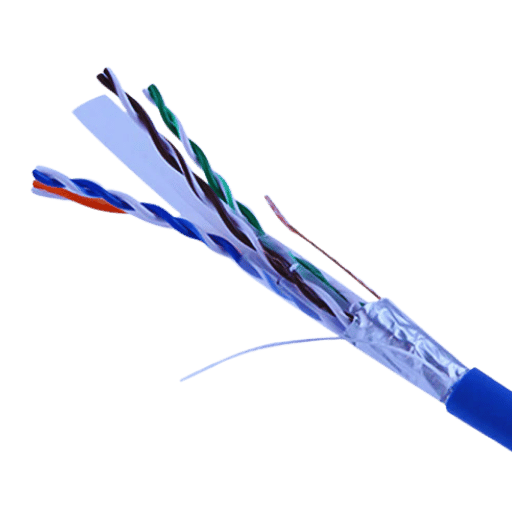
How does the shield protect the cable?
EMI and RFI are the two things that the shield protects the conductors from in a Shielded Cat6 Ethernet cable. This is done by wrapping each pair of wires with a layer made of either foil or braided copper. The outer layer acts as an insulator that stops external interference from degrading signals, therefore making crosstalk between wire pairs minimal so data can travel further without being lost or corrupted.
What are the main uses for Shielded Cat6 cables?
Shielded Cat6 cables are used where high data rates and reliability are a must. Some common applications include:
- Enterprise Networking: Perfect for office settings where you need strong connections between computers, servers, and other network devices so that they can support fast data transfer speeds while minimizing interference caused by electrical noise or magnetic fields.
- Data Centers: In these environments, it is common place to find many cables being run throughout the building; therefore, Shielded Cat6 Cables are used since they help with handling large amounts of cabling infrastructure without losing too much signal quality due to crosstalk which is when one wire’s signal interferes with another wire’s ability to transmit its own signal clearly enough for it be understood on the other end.
- Audio/Visual Systems: When sending audio signals over long distances clarity might become an issue which makes this type of cable necessary in places like conference rooms or entertainment venues where people gather together in order listen or watch something.
- Industrial Environments – Industrial machines can create huge amounts of electromagnetic interference so shielding becomes very important if you want your communication lines working properly around such areas.
- Residential Networks – This refers mainly towards smart home installations which rely heavily upon streaming services like Netflix, gaming consoles such as Xbox One S or PS4 Pro (which require stable internet connection) etc. Here Shielded Category 6 Cable would be necessary due its enhanced performance capabilities over standard UTP cables thus making sure everything runs smoothly even during peak usage times.
These examples show how flexible and efficient Shielded Category 6 Cabling can be within different network setups.
How does it differ from Unshielded Cat6 cables?
The construction and prevention of interference efficiency of Shielded Cat6 cables vary from those of Unshielded Cat6 cables in one major way. Usually, shielded Cat6 cables are equipped with an extra shielding layer around each wire pair, which is usually made of foil or braided copper, which protects them from electromagnetic interference (EMI) as well as crosstalk. This quality makes them the best option for areas with high levels of electronic noise, such as industrial facilities or data centers.
However, unshielded cat6 cables do not have this additional protection; hence, they are more likely to be affected by external interferences. Their performance lowers when used in places where there is much noise around, although they can still work well in homes and other environments with fewer disturbances. Furthermore, compared to unshielded ones, shielded CAT 6 cables support longer distances without losing signal strength, thus providing reliable data transmission for robust applications. Therefore, it largely depends on the surroundings under which one intends to operate a network and whether he/she should use Shielded or Unshielded Category 6 cables.
Why Choose Shielded Cat6 Over Other Ethernet Cables?
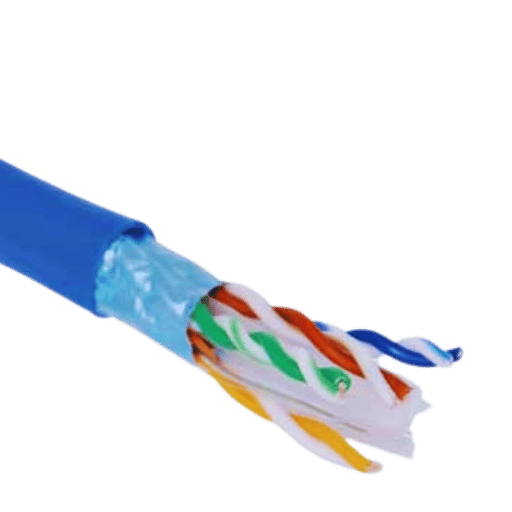
Benefits of using Cat6 shielded cables
- Less disturbances: In a noisy environment, Cat6 shielded cables decrease EMI and crosstalk, thereby ensuring better signal integrity.
- Better performance: With these cables, data can be transmitted at higher rates and over longer distances without much loss of signal strength.
- Durability: An extra layer of shielding acts as a physical barrier between wires inside them against outside elements that could damage them.
- Universal use cases: These types of wires are ideal for places with lots of electronic interferences like data centers or industrial areas among others.
- Future readiness: Shielding allows more bandwidths to pass through, which enables it to support bigger networks, thus making it a good investment in the long run.
Performance comparison with Cat5e and Cat6 Unshielded cables
Comparing Cat6 shielded cables to unshielded Cat6 and Cat5e shows a significant difference in performance.
Data rates:
- Cat5e cables can support speeds of up to 1 Gbps (Gigabit Ethernet) at a maximum distance of 100 meters while on the other hand, Cat6 cables can support speeds of up to 10 Gbps over shorter distances (up to 55 meters) and still maintain 1 Gbps up to 100 meters. Shielded Cat6 cables are the best for use in high-interference environments as they ensure stable data rates.
Bandwidth:
- While unshielded Cat6 cables offer a bandwidth of 250 MHz, Cat5e only offers 100 MHz. However, this capacity can be increased further with shielded Cat6, which ensures more resistance against noise, thus making it work better under harsh conditions.
Signal Integrity:
- Shielding makes signal integrity better in case of Cat6 than both cat5e or unshielded cat6 since it protects from electromagnetic interference (EMI). In such an environment where there is potential EMI exposure; unshielded versions may experience degradation in their performance levels.
In general terms if we prioritize high-speed data transmission together with reliability across different environments then using cat six shielded cable would be more advantageous than any other solution like cat five e or even un-shielded cat six.
Real-world applications of Shielded Cat6 cables
Shielded Category 6 cables are useful in places where there is need to minimize noise interference and ensure data integrity. Some environments where they can be used include:
- Data centers: Shielded Cat6 cables guarantee high-speed connections between servers or other network devices in areas with high data traffic like data centers. The extra shielding reduces crosstalk hence minimizing electromagnetic interferences that could affect the performance and uptime of such systems.
- Video conferencing systems: These types of cables offer steady links for video conference equipments which require stable bandwidths with minimal delays or latencies. They are best suited for corporate setups where effective communication is needed because they enable transmission of quality audios and videos.
- Industrial automation: Shielded Category 6 cables help maintain the quality of signals where heavy electromagnetic interferences might be produced by different industrial equipment. They allow for communication between automated machines and control systems, thus ensuring smooth operations and the exchange of information.
Generally, shielded Category 6 cables can be used in a wide range of demanding environments, including corporate offices up to industrial applications, due to their flexibility when it comes to performance and reliability requirements.
How to Install Shielded Cat6 Ethernet Cables?
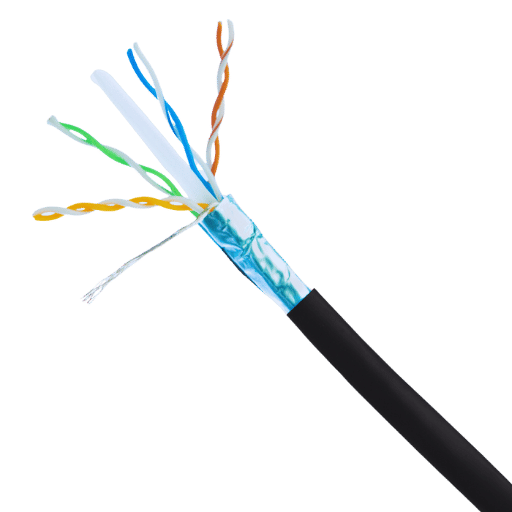
Step-by-step installation guide
- Gather Materials: Find an insulated Cat6 cable, connectors, a wire crimper, cable cutter/stripper and tester.
- Measure and Cut the Cable: Measure the length required for your installation and cut the cable accordingly with some margin for adjustment.
- Strip the Cable: With care, use wire strippers to remove about two inches of outer sheathing from both ends of the cable so that you can see the twisted pairs inside.
- Arrange Wires: Separate the wires from each other and put them in order according to T568A or T568B standards colours given out.
- Insert Wires into Connectors: Then insert wires into connectors ensuring that every wire goes up to its end and then clicks securely into place.
- Crimp the Connectors: Use a cable crimping tool to attach connectors to cables thus making sure that they are strongly connected together.
- Test the Cable: Test connectivity using a cable testing tool. It will also help avoid wiring errors along with troubleshooting any faults if present at this stage as well.
- Repeat: Repeat these steps for other ends of your cables if needed; other cables may be involved in setting-up too.
Required tools and materials
Below are some of the items necessary for a successful installation of shielded Cat6 Ethernet cables:
- Main material: Shielded Cat6 Cables.
- Connectors: RJ45 connectors made for Cat6 wires.
- Cable Crimper: Device fixing connectors to cable in a secure way.
- Wire Cutter/Stripper: Tool that cuts and strips the cable jacket and wires at once.
- Cable Tester: This is for ascertaining the good quality and working status of installed wires.
- Measuring Tape: This is used to measure the length of wire needed.
- Labeling Material: Marking/writing on the cord that can help in its identification is optional but advised
This will make sure that the network operates well and that there is an efficient system during installation.
Common installation mistakes to avoid
To obtain the best performance, one must not commit some mistakes at time of installing shielded Cat 6 Ethernet cables:
- Wrong Cable Length: Overestimating or underestimating the length of cable required causes unnecessary bends and strain. Always make accurate measurements to avoid any slack or tensioning in the installation.
- Inadequate Termination Techniques: Faulty termination of cables can lead to poor connectivity. Wire stripping should be done accurately, wires neatly arranged and correctly crimped for signal integrity.
- Neglecting Post-installation Testing of Cables: Failure to test cables with a cable tester immediately after installation could leave undiscovered issues that affect network performance. Ensure all connections are integrity checked before completing the installation.
These pitfalls must be kept in mind by every installer so as to improve the reliability and productivity of their networks.
What Makes a Good Quality Shielded Cat6 Cable?
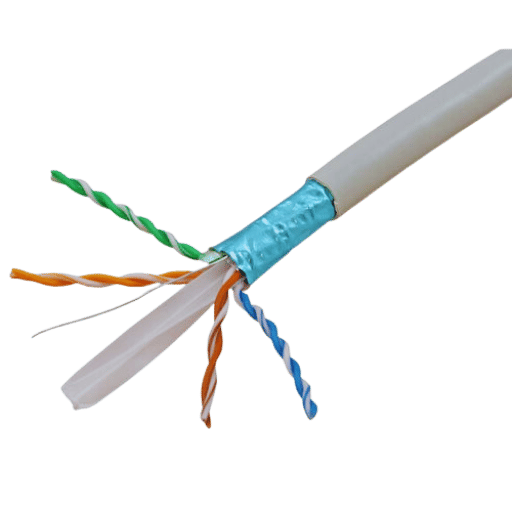
Important features to look for
When choosing a good Cat6 Ethernet cable which is shielded, you should think of the following features:
- Shielding Type: Go for foiled twisted pair (FTP) or screened twisted pair (STP) to protect yourself from electromagnetic interferences.
- Cable Jacket Material: Always go for a durable and fire-retardant jacket like PVC or LSZH (Low Smoke Zero Halogen) to assure safety and durability.
- Wire Gauge: The best choice is 23 AWG wires since they have better performance at long distances.
- Certification: To make sure it complies with industry standards in terms of quality control, make sure that the cable follows TIA/EIA-568 specification.
- Bandwidth Capability: It should be able to support bandwidths up to 550MHz which is suitable for high-speed data transfer rates.
These are vital characteristics that help maintain high levels of performance in network connectivity.
Recommended brands and manufacturers
Consider the following well-known brand names if you are looking to buy shielded Cat6 Ethernet cables that have good reputations for being reliable and of high quality:
- Mediabridge: Known for high-performance cables with strong protection and tough construction.
- Cable Matters: Offers several varieties of Cat6 shielded cables which are up to industry standards as well as offering excellent signal integrity.
- Mogami: Mogami is known for its top-notch cables; these cables offer the best fidelity and durability and, hence, are very popular among professionals.
- Jadaol: Jadaol offers highly-shielded flexible wires that come in handy when configuring different types of networks. This helps reduce interference during transmission.
- Mediacom: They emphasize using top-grade materials and extensive testing to ensure their products meet stated bandwidth requirements.
By choosing from these brands, you can get the most out of your network system in terms of performance and dependability.
How to test the quality of Shielded Cat6 Ethernet cables?
To make sure that the quality of shielded Cat6 Ethernet cables is up to standard and reliable, testing is necessary. The methods below are summarized from leading industry sources:
- Cable Tester: An excellent cable tester must guarantee continuity, identify wire flaws and integrity for signal transmission. It’s preferred to choose a tester which can access performance levels of 1Gbps or more.
- Fluke Networks Testing: Fluke Network testing equipment are recommended such as DSX-5000 for thorough evaluation. Insertion loss, return loss and near-end crosstalk (NEXT) are some parameters measured by this device to ascertain whether the cable adheres to performance requirements set for high-speed applications.
- Packet Loss and Throughput Tests: Iperf or Wireshark software tools can be used in conducting packet loss and throughput tests. This will help you evaluate the network’s overall performance with the cable on it, thus enabling you to locate any weak points or interruptions that may arise during transmission.
By regularly carrying out these procedures on your shielded cat6 ethernet cables, you can maintain a high-performance network environment and overcome possible connectivity problems.
FAQs About Shielded Cat6 Ethernet Cables
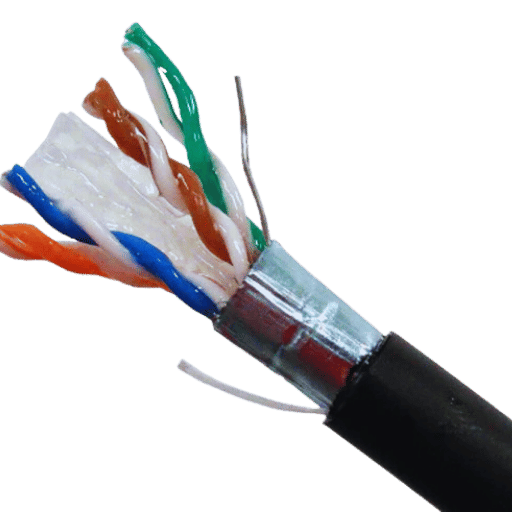
Can Shielded Cat6 cables be used outdoors?
Certainly, outside is where shielded Cat6 cables can be used. On the condition that they are rated for outdoor usage. It usually has a protective covering that defends against moisture, UV light from the sun and temperature changes among other things. Therefore, making use of properly graded wires guarantees their strength and efficiency over a long period once they are set up in open air settings.
What is the maximum length for Shielded Cat6 cables?
Shielded Cat6 cables can reach a maximum length of 100 meters (328 feet) when transmitting data. This is the total distance covered by horizontal runs and patch cable lengths combined. Signal quality deteriorates after this point, resulting in problems such as higher attenuation and vulnerability to external signals. Hence, it is recommended that you observe the limit mentioned above during the planning or implementation stage of your network setup to ensure best performance.
How to identify genuine Shielded Cat6 cables?
When identifying genuine Shielded Cat6 cables, there are certain things to look for – physical inspection, labelling, and performance testing.
- Physical Inspection: These types of cable should be thicker than unshielded ones due to extra shielding that could be foil or braided copper. Check the insulation for any indications of a standard like “Cat6” or “S/FTP” (Shielded Foiled Twisted Pair) and also ensure the outer jacket is tough enough; it’s commonly made from high-quality polyethylene or PVC which protects against environment elements.
- Labeling: Manufacturers who follow good manufacturing practices always label their products correctly by indicating relevant specifications, including category rating, manufacturer details, and compliance with applicable standards such as ANSI/TIA-568, etc., sometimes they even use unique serial numbers or QR codes so that customers can easily verify authenticity.
- Testing Performance: Another way of establishing whether what you have is a genuine Shielded Cat6 cable is by performing some tests on it using network testing tools. A cable has to meet at least 250 MHz bandwidth standards and be able to support data rates up to 10 Gbps for distances not exceeding 55 meters. Tools like cable certifiers or Ethernet testers can be used in measuring crosstalk, insertion loss, and return loss, among other parameters, so as to confirm if, indeed, this is what was expected from the manufacturer.
- Manufacturer Reputation: Counterfeit products are more likely when one buys from unknown brands therefore going for well-established manufacturers significantly reduces chances of falling into such traps. Besides, customer feedback together with industry certifications can also help a lot when trying to gauge trustworthiness levels associated with different suppliers out there in the market today.
In conclusion, these guidelines will enable users to recognize authenticity, thus enabling them to maintain efficiency within their networks.
Reference Sources
Category 6 cable
Ethernet
Electrical cable
Frequently Asked Questions (FAQs)
Q: What is a Shielded Cat6 Ethernet Cable?
A: A high-performance network cable which can resist a large amount of electromagnetic interference (EMI) is known as Shielded Cat6 Ethernet Cable. It contains an overall foil shield that defends data transmission against disturbances hence making it more dependable than unshielded cables.
Q: When should I use a Shielded Cat6 Ethernet Cable?
A: Use a Shielded Cat6 Ethernet Cable in places with massive EMI, like industries or data centers, since it helps maintain stable and reliable network performance.
Q: What are the benefits of using Shielded Cat6 Ethernet Cables over Cat5 or Cat5e cables?
A: Compared to cat5 or cat5e, shielded cat6 ethernet cables have wider bandwidths (up to 550MHz) and faster rates of data transfer. They also offer more protection from EMI thus ensuring cleaner transmission of information.
Q: Are Shielded Cat6 Cables compatible with regular RJ45 connectors?
A: While shielded cat6 cables can work with standard rj45 connectors, it is advisable to use the latter because they help in preserving total shielding benefits.
Q: What is the difference between Cat6 and Cat6a Ethernet Cables?
A: In comparison to 1 Gigabit and 550MHz for normal cat- 6 wires, enhanced versions called cat- 6a ones offer higher speeds reaching up to 10 Gigabits per second(Gb/s) alongside supporting larger bandwidths which extend up to 650 MHz. Additionally, they minimize crosstalk and interference over longer distances through better shielding.
Q: In what lengths are Shielded Cat6 Ethernet Cables sold?
A: There are different available lengths of Shielded Cat6 Ethernet Cables, including bulk quantities such as 1000ft for larger installations. Patch cables are also available in shorter, more convenient lengths for smaller setups and connections.
Q: What does “23AWG solid” mean for Shielded Cat6 Ethernet Cables?
A: In the context of Shielded Cat6 Ethernet Cables, “23AWG solid” means wire gauge and construction; which is to say that it uses 23 American Wire Gauge solid copper conductors instead of stranded ones – this gives them better electrical performance and durability.
Q: Can I use Shielded Cat6 Ethernet Cables outside?
A: Yes, you can use Shielded Cat6 Ethernet Cables outdoors but ensure you only use the ones with a cable rated for outdoor (usually called “riser”, or “cat6 outdoor ethernet cable”).
Q: What are some typical applications for these cables?
A: These types of cables are most commonly used in high-performance network installations, data centers, industrial environments – any set up where there is a need to transfer data at high speeds with minimum interference.
Q: How do I install Shielded Cat6 Ethernet Cable properly?
A: Correct installation involves using appropriate shielded connectors and patch panels, grounding the shields correctly, and avoiding physical damage to the cables. The best performance can be achieved by following manufacturer guidelines and best practices for cabling infrastructure.
Post Views: 4,212




